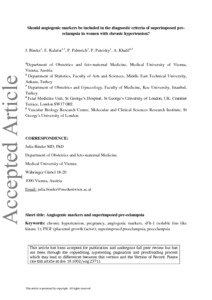Binder, J; Kalafat, E; Palmrich, P; Pateisky, P; Khalil, A
(2022)
Should angiogenic markers be included in diagnostic criteria of superimposed pre-eclampsia in women with chronic hypertension?
Ultrasound Obstet Gynecol, 59 (2).
pp. 192-201.
ISSN 1469-0705
https://doi.org/10.1002/uog.23711
SGUL Authors: Khalil, Asma
![[img]](https://openaccess.sgul.ac.uk/113405/1.hassmallThumbnailVersion/uog.23711.pdf)  Preview |
|
PDF
Accepted Version
Available under License ["licenses_description_publisher" not defined].
Download (1MB)
| Preview
|
Abstract
Objective
Although the most recent guidance from the International Society for the Study of Hypertension in Pregnancy (ISSHP) has highlighted the role of angiogenic marker assessment in the diagnosis of pre-eclampsia (PE) in women with chronic hypertension, the ISSHP has withheld recommending its implementation due to the limited available evidence in this group of women. Therefore, we aimed to investigate the value of soluble fms-like tyrosine kinase-1 (sFlt-1) and placental growth factor (PlGF) assessment in women with chronic hypertension and suspected superimposed PE.
Methods
This was a retrospective analysis of prospectively collected data recorded in an electronic database between January 2013 and October 2019. Women with chronic hypertension and singleton pregnancy who had suspected superimposed PE were included. Superimposed PE was suspected in women presenting with worsening hypertension, epigastric pain, new-onset edema, dyspnea or neurological symptoms. The exclusion criteria were delivery within 1 week after assessment for reasons other than PE, chronic kidney disease, history of cardiac disease, fetal aneuploidy, genetic syndrome or major structural anomaly and missing pregnancy outcome. Maternal serum angiogenic markers (sFlt-1, PlGF and sFlt-1/PlGF ratio) were measured. The primary outcome was the utility of angiogenic markers in the prediction of superimposed PE. Predictive accuracy was assessed for superimposed PE diagnosed at different timepoints, including within 1 week after assessment and any time before birth. The secondary outcome was comparison of adverse maternal and perinatal outcomes between women with superimposed PE diagnosed according to the traditional ISSHP criteria and those diagnosed according to extended criteria including angiogenic markers. The predictive accuracy of each angiogenic marker was assessed using receiver-operating-characteristics-curve analysis. Area under the curve (AUC) values were compared using De Long's test. A sensitivity analysis was planned for gestational age at assessment. The association of various variables with composite adverse maternal and perinatal outcomes was assessed using binomial regression.
Results
The study included 142 pregnant women with chronic hypertension and suspected superimposed PE, of whom 25 (17.6%) developed PE within 1 week after assessment, 52 (36.6%) developed PE at any timepoint before birth and 90 (63.4%) delivered without PE. Maternal serum angiogenic imbalance was associated significantly with superimposed PE diagnosed according to the ISSHP criteria within 1 week or at any time after assessment (P < 0.001 for both). The predictive accuracy of maternal serum sFlt-1/PlGF ratio for superimposed PE diagnosed within 1 week after assessment was superior to that of maternal serum PlGF level (AUC, 0.91 vs 0.86; P = 0.032). The addition of angiogenic imbalance to the traditional ISSHP diagnostic criteria was associated with an increase in the detection rate (35.1% increase; 95% credible interval (CrI), 16.6–53.6%) and positive (9.6% increase; 95% CrI, 0.0–20.6%) and negative (3.1% increase; 95% CrI, 1.3–4.9%) predictive values for composite adverse maternal outcome, with high posterior probabilities of an increase in each predictive accuracy parameter (> 99.9%, 95.6% and > 99.9%, respectively), without a meaningful decrease in specificity. The addition of angiogenic imbalance improved the detection rate for composite adverse perinatal outcome (20.6% increase; 95% CrI, 0.0–42.2%), with a high posterior probability (96.9%). There was a corresponding drop in specificity (5.7% decrease; 95% CrI, −2.3% to 13.6%), with a posterior probability of 91.8%.
Conclusions
In women with chronic hypertension and suspected superimposed PE, addition of maternal serum angiogenic markers to the traditional diagnostic criteria for superimposed PE improved significantly the sensitivity for the prediction of both maternal and perinatal adverse outcomes. Implementation of angiogenic marker assessment in the evaluation of pregnant women with chronic hypertension should therefore be considered.
| Item Type: |
Article
|
| Additional Information: |
This is the peer reviewed version of the following article: Binder, J., Kalafat, E., Palmrich, P., Pateisky, P. and Khalil, A. (2022), Should angiogenic markers be included in diagnostic criteria of superimposed pre-eclampsia in women with chronic hypertension?. Ultrasound Obstet Gynecol, 59: 192-201, which has been published in final form at https://doi.org/10.1002/uog.23711. This article may be used for non-commercial purposes in accordance with Wiley Terms and Conditions for Use of Self-Archived Versions. |
| Keywords: |
angiogenic markers, chronic hypertension, preeclampsia, pregnancy, sFlt-1 (soluble fms like kinase 1); PlGF (placental growth factor); superimposed preeclampsia, 1114 Paediatrics and Reproductive Medicine, Obstetrics & Reproductive Medicine |
| SGUL Research Institute / Research Centre: |
Academic Structure > Molecular and Clinical Sciences Research Institute (MCS) |
| Journal or Publication Title: |
Ultrasound Obstet Gynecol |
| ISSN: |
1469-0705 |
| Language: |
eng |
| Dates: |
| Date | Event |
|---|
| 1 February 2022 | Published | | 24 June 2021 | Published Online | | 4 June 2021 | Accepted |
|
| Publisher License: |
Publisher's own licence |
| PubMed ID: |
34165863 |
 |
Go to PubMed abstract |
| URI: |
https://openaccess.sgul.ac.uk/id/eprint/113405 |
| Publisher's version: |
https://doi.org/10.1002/uog.23711 |
Statistics
Item downloaded times since 08 Jul 2021.
Actions (login required)
 |
Edit Item |



